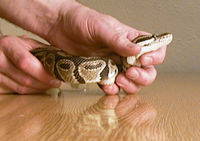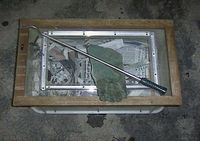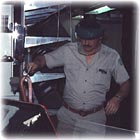Difference between revisions of "Snake Handling and Restraint"
m (Snake Safety and Handling moved to Snake Handling and Restraint: wrong subject title) |
|||
| Line 1: | Line 1: | ||
{{unfinished}} | {{unfinished}} | ||
| + | [[Image:snakeheadhold.jpg|200px|thumb|right|Correct method to restrain snakes - ©RVC and its licensors, Peer Zwart and Fredric Frye. All rights reserved]] | ||
==Physical restraint== | ==Physical restraint== | ||
| + | The best method for transport of non-venomous and non-aggressive species is simply a cotton bag into which snakes will often retreat voluntarily. Prior to handling any snake it is important to establish the species otherwise dangerous snakes may be inadvertently handled without due care. Ideally snakes should be handled minimally. Hypothermia is not a method of restraint. The oculovasal reflex is not seen in snakes. When handling a snake for the first time it is safest to grasp just behind a snake’s head before lifting the rest of the body. | ||
| + | [[Image:Glove_and_hook.jpg|200px|thumb|right|©RVC and its licensors, Peer Zwart and Fredric Frye. All rights reserved]] | ||
===Handling=== | ===Handling=== | ||
| − | Nonvenemous snakes should be physically restrained by holding the head at the quadrate/mandible level and supporting the body of the snake. For every three to four feet of snake body, an extra handler should be positioned to support the spine. A snake should never be handled by being placed around the neck of a human. The behaviour of the animal should be observed from a distance prior to grasping. | + | Nonvenemous snakes should be physically restrained by holding the head at the quadrate/mandible level and supporting the body of the snake. For every three to four feet of snake body, an extra handler should be positioned to support the spine. A snake should never be handled by being placed around the neck of a human. The behaviour of the animal should be observed from a distance prior to grasping. Large constrictors should only be handled when there are two people present. They are extremely powerful and a single handler is in danger of injury, even death. There may also be legal considerations regarding the possession of dangerous animals so ascertain that these are fulfilled. |
| − | + | [[Image:Snake_hook_1.jpg|200px|thumb|right|Safety equipment - ©RVC and its licensors, Peer Zwart and Fredric Frye. All rights reserved]] | |
| − | Large constrictors should only be handled when there are two people present. They are extremely powerful and a single handler is in danger of injury, even death. There may also be legal considerations regarding the possession of dangerous animals so ascertain that these are fulfilled. | ||
| − | |||
===Venomous snakes=== | ===Venomous snakes=== | ||
| − | Venomous snakes should obviously only be handled by experienced personnel with appropriate equipment and preferably be treated by experienced veterinarians. Proper identification of any venomous snakes is of the utmost importance. | + | Venomous snakes should obviously only be handled by experienced personnel with appropriate equipment and preferably be treated by experienced veterinarians. Restraint aids include snake hooks and clear tubing. Gloves and nooses are best not used because of the potential for unintentional injury. Proper identification of any venomous snakes is of the utmost importance, and antivenin should always be readily available. In case of a human bite, it is necessary to have quick access to this antivenin. A veterinarian working with venomous snakes needs to be aware of the laws regarding dangerous animals. Possession of venomous snakes is regulated so make certain that the owner has the appropriate licences. Also check with the appropriate authorities if you, the veterinarian, need to be specially licensed to treat or house venomous snakes. |
*At least two people should always be involved in handling a venomous snake | *At least two people should always be involved in handling a venomous snake | ||
*Large, obvious signs that read "VENOMOUS SNAKE" should be placed on the outside of the enclosure | *Large, obvious signs that read "VENOMOUS SNAKE" should be placed on the outside of the enclosure | ||
*An emergency telephone with essential contact numbers should be located nearby of venomous snake enclosures | *An emergency telephone with essential contact numbers should be located nearby of venomous snake enclosures | ||
*An antivenin protocol should be developed with a local hospital | *An antivenin protocol should be developed with a local hospital | ||
| − | + | ==Chemical restraint== | |
| − | + | Restraint can be induced by parenteral injection of a variety of sedatives. Ketamine is a commonly used dissociative. To facilitate intravenous induction ketamine can be administered by intramuscular injection at 20 mg/kg. This may take up to 30 minutes to take effect. The dosage may be increased up to 50 mg/kg. Diazepam and midazolam (2 mg/kg) have also been advised alone or in combination with ketamine. | |
'''Useful resources''' | '''Useful resources''' | ||
*[http://www.merckvetmanual.com/mvm/index.jsp?cfile=htm/bc/213400.htm&word=snakes Snakebite Introduction (invenomation treatment) - The Merck Veterinary Manual] | *[http://www.merckvetmanual.com/mvm/index.jsp?cfile=htm/bc/213400.htm&word=snakes Snakebite Introduction (invenomation treatment) - The Merck Veterinary Manual] | ||
[[Category:Snake_Husbandry]] | [[Category:Snake_Husbandry]] | ||
| − | [[Category: | + | [[Category:Snake Examination]][[Category:Snake Examination]] |
Revision as of 11:11, 4 March 2010
| This article is still under construction. |
Physical restraint
The best method for transport of non-venomous and non-aggressive species is simply a cotton bag into which snakes will often retreat voluntarily. Prior to handling any snake it is important to establish the species otherwise dangerous snakes may be inadvertently handled without due care. Ideally snakes should be handled minimally. Hypothermia is not a method of restraint. The oculovasal reflex is not seen in snakes. When handling a snake for the first time it is safest to grasp just behind a snake’s head before lifting the rest of the body.
Handling
Nonvenemous snakes should be physically restrained by holding the head at the quadrate/mandible level and supporting the body of the snake. For every three to four feet of snake body, an extra handler should be positioned to support the spine. A snake should never be handled by being placed around the neck of a human. The behaviour of the animal should be observed from a distance prior to grasping. Large constrictors should only be handled when there are two people present. They are extremely powerful and a single handler is in danger of injury, even death. There may also be legal considerations regarding the possession of dangerous animals so ascertain that these are fulfilled.
Venomous snakes
Venomous snakes should obviously only be handled by experienced personnel with appropriate equipment and preferably be treated by experienced veterinarians. Restraint aids include snake hooks and clear tubing. Gloves and nooses are best not used because of the potential for unintentional injury. Proper identification of any venomous snakes is of the utmost importance, and antivenin should always be readily available. In case of a human bite, it is necessary to have quick access to this antivenin. A veterinarian working with venomous snakes needs to be aware of the laws regarding dangerous animals. Possession of venomous snakes is regulated so make certain that the owner has the appropriate licences. Also check with the appropriate authorities if you, the veterinarian, need to be specially licensed to treat or house venomous snakes.
- At least two people should always be involved in handling a venomous snake
- Large, obvious signs that read "VENOMOUS SNAKE" should be placed on the outside of the enclosure
- An emergency telephone with essential contact numbers should be located nearby of venomous snake enclosures
- An antivenin protocol should be developed with a local hospital
Chemical restraint
Restraint can be induced by parenteral injection of a variety of sedatives. Ketamine is a commonly used dissociative. To facilitate intravenous induction ketamine can be administered by intramuscular injection at 20 mg/kg. This may take up to 30 minutes to take effect. The dosage may be increased up to 50 mg/kg. Diazepam and midazolam (2 mg/kg) have also been advised alone or in combination with ketamine.
Useful resources


